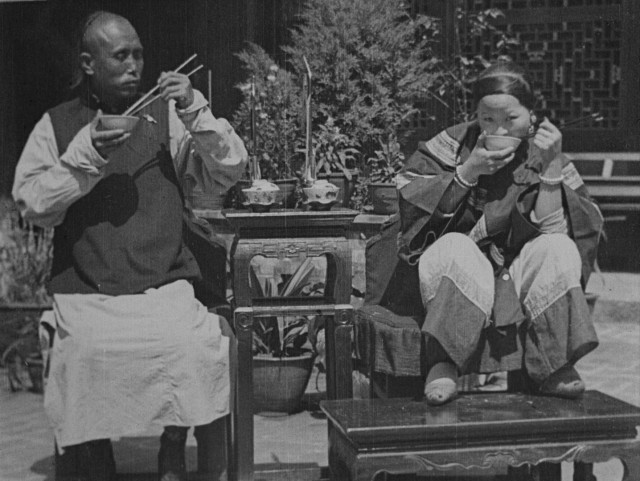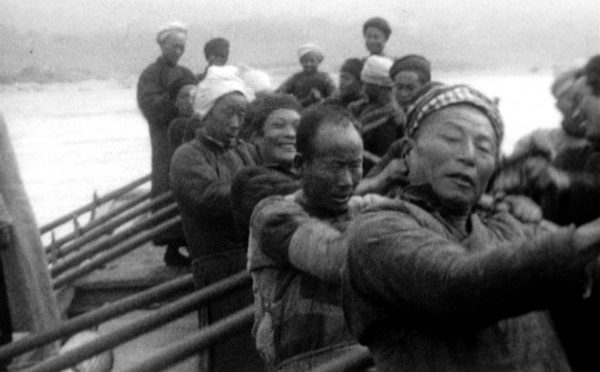
China has a rich history, documented for over four thousand years, but despite the length and breadth of that history much has been lost in time thanks to the Cultural Revolution that began in the 1960s.
Consequently, little of historical value remains of home grown Chinese film makers from the first half of the 20th century, so the archive material made by Western film makers and retained by the likes of the British Film Institute becomes even more important.
AROUND CHINA WITH A MOVIE CAMERA is a collection of films put together from the BFI National Archive which have survived the cultural purge. There are a mixture of home movies, travelogues, newsreels and other footage which paint a portrait of both urban and rural Chinese life in the first half of the twentieth century. Some of the footage, despite the best restoration efforts of the BFI curators, is inevitably scratchy and worn but this adds to the sense of authenticity and most of the films stand up to the quality of their Western contemporaries of the era.
The title may sound reminiscent of the seminal Russian documentary MAN WITH A MOVIE CAMERA, but that was a vision of a single director Dziga Vertov and it employed a host of cinematic camera tricks, feats for which it is still highly regarded today. What this film shares with that, other than a 68 minute running time, is a variety of styles and cinematography, including tints and colour filters applied by the original film makers which help to bring the footage to life.
What the films also share is a lack of actors and of a through narrative, consisting simply of the footage shot at the time; often, bemused passers-by wander past, gawping at the camera in a manner still familiar today to anyone that’s used a home video camera in a public place. That’s not to say that the footage lacks a thread of focus, with the intertitles clearly explaining the context and background of each piece of film as we embark on an extended tour of the Chinese provinces. From initial bustling city streets, to the more rural provinces and then back to the clamour of Hong Kong and Shanghai, the footage spans nearly five decades and shows a gradual progress and modernisation that isn’t too difficult to extrapolate to the towering skyscrapers of today.
The influences of dance music and electronica augment the thrumming rhythms of the busy street scenes superbly…
The film avoids political agendas and largely avoids reference to world events of the time. The one exception is the Shanghai Uprising, a massacre in 1927 that claimed more than 100 lives and saw thousands imprisoned or missing. There’s no direct footage of the massacre but footage taken just before shows both the diverse mix of life on Shanghai’s streets, including their Sikh police force and the heavy Western influences in shops and services, as well as rising tension and soldiers on the streets.
What the film as a whole is very successful in doing is painting a broad picture of Chinese life over an extended period. The footage has been carefully chosen, and both the more imposing footage of Hong Kong harbour pre-tower blocks and the quieter village scenes of workers tending to their crops give a real sense of life in that time and place. Smaller details, such as camel drivers picking up droppings with long handled devices or a troupe of boy acrobats performing tricks, add levity to what could otherwise have been a dry selection of clips.
The other star of this compilation is the film’s composer, Ruth Chan. Rather than setting for a period score, she has taken a mixture of instruments: both Western, such as an accordion and double bass, and Chinese flutes and a two-stringed fiddle called an erhu. The score also combines a variety of influences: for example, combining pentatonic scales and early Western music styles such as the Lydian mode, which can be dovetailed together (or in English, combining a scale of the black notes on a piano and its Chinese sound with the kind of scales used in early Gregorian chanting) to create a score that feels modern rather than ancient. The influences of dance music and electronica augment the thrumming rhythms of the busy street scenes superbly, and give the viewer the effect of being transported directly into the era, rather than peering distantly back at it.
AROUND CHINA WITH A MOVIE CAMERA’s most touching moment may come at the very end: two brief pieces of footage which may date to around 1900 or earlier, and could be the oldest surviving footage of China in existence. It’s a culmination of a fifty-year journey through a country that provides a captivating glimpse into life in China before the Revolution.
httpvh://youtu.be/dQiEzB-K3i0

